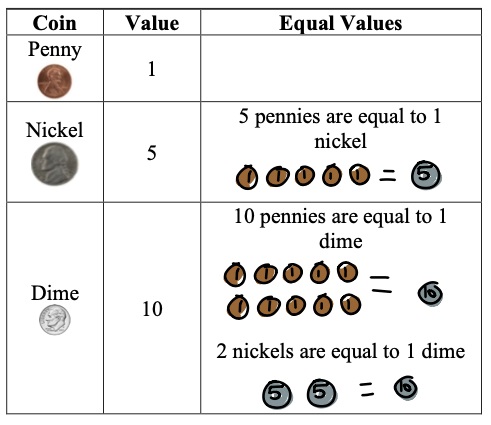General Information
Benchmark Instructional Guide
Connecting Benchmarks/Horizontal Alignment
Terms from the K-12 Glossary
- NA
Vertical Alignment
Previous Benchmarks
Next Benchmarks
Purpose and Instructional Strategies
The purpose of this benchmark is for students to relate skip counting by 5s and 10s with counting a sequence of coins or bills. Students will relate the coin or bill to its value. In Kindergarten, students skip counted by 10s (MTR.2.1, MTR.5.1, MTR.7.1).- Instruction includes and reinforces strategies for addition.
- Instruction includes helping students to realize that it may be easier to first skip count by tens using dimes, and then by fives using nickels, with pennies being added last.
- Instruction includes making a connection to tally marks by putting pennies into groups of five.
- Instruction uses the format 25¢, not $0.25.
Common Misconceptions or Errors
- Students may believe the value of a coin is directly related to its size (e.g., a nickel is bigger than a dime and is worth more, or a penny is bigger than a dime, so it must also be worth more). In these cases students need additional practice identifying a coin with its actual value.
- Students may not count coins as a sequence of their value and make mistakes in counting. In these cases, have students identify coins with their value prior to counting. Then have students explore ways to count the coins that make sense for them (i.e., counting dimes then nickels and pennies).
Strategies to Support Tiered Instruction
- Since combinations of pennies, nickels, and dimes are up to one dollar, provide students with a hundreds chart to organize their coins and provide opportunities to see that it may be easier to first skip count by tens using dimes, and then skip count by fives using nickels, with pennies being counted last by ones.

- Teacher provides opportunities to trade coins for equal values to find it easier to count the coin collection and to practice counting coin collections.
For example, students can take turns “trading up to a dollar (or 100 dollars)” using a tray of sorted coins pennies, nickels, and dimes (or one, five, and ten dollar bills), enough to allow for multiple rounds of trading, and dice or dot cards. Each student will take a turn rolling a die or flipping a dot card. On their turn, the student takes that many pennies (or dollars) from the bank, counts the total amount they have, and then determines if a “trade” can be made (i.e., trade 5 pennies for a nickel or 2 nickels for a dime.) Each student continues to take turns and make trades until one player has enough to exchange for the $1 (or $100 dollar) bill.


Instructional Tasks
Instructional Task 1 (MTR.7.1)
- Part A. Matt counted coins that he found in his pocket. How much money does he have?

- Part B. Matt’s friend gave him the five coins shown below. Count on from the coins Matt had in his pocket. How much money does Matt have now?

Instructional Items
Instructional Item 1
There are three dimes and seven pennies on the table. What is the total value of the coins?
Instructional Item 2
What is the value of the coins shown?
Instructional Item 3
What is the value of the dollar bills shown?
*The strategies, tasks and items included in the B1G-M are examples and should not be considered comprehensive.
